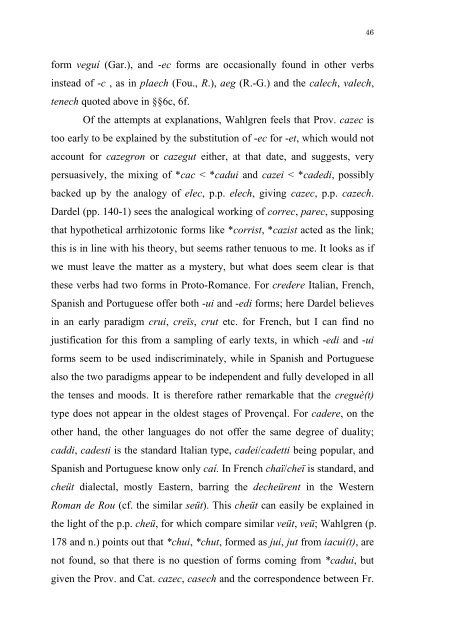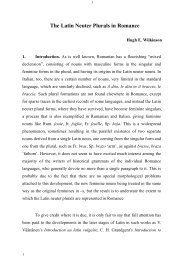THE STRONG PERFECTS IN THE ROMANCE ... - Page ON
THE STRONG PERFECTS IN THE ROMANCE ... - Page ON
THE STRONG PERFECTS IN THE ROMANCE ... - Page ON
Create successful ePaper yourself
Turn your PDF publications into a flip-book with our unique Google optimized e-Paper software.
form veguí (Gar.), and -ec forms are occasionally found in other verbs<br />
instead of -c , as in plaech (Fou., R.), aeg (R.-G.) and the calech, valech,<br />
tenech quoted above in §§6c, 6f.<br />
Of the attempts at explanations, Wahlgren feels that Prov. cazec is<br />
too early to be explained by the substitution of -ec for -et, which would not<br />
account for cazegron or cazegut either, at that date, and suggests, very<br />
persuasively, the mixing of *cac < *cadui and cazei < *cadedi, possibly<br />
backed up by the analogy of elec, p.p. elech, giving cazec, p.p. cazech.<br />
Dardel (pp. 140-1) sees the analogical working of correc, parec, supposing<br />
that hypothetical arrhizotonic forms like *corrist, *cazist acted as the link;<br />
this is in line with his theory, but seems rather tenuous to me. It looks as if<br />
we must leave the matter as a mystery, but what does seem clear is that<br />
these verbs had two forms in Proto-Romance. For credere Italian, French,<br />
Spanish and Portuguese offer both -ui and -edi forms; here Dardel believes<br />
in an early paradigm crui, creïs, crut etc. for French, but I can find no<br />
justification for this from a sampling of early texts, in which -edi and -ui<br />
forms seem to be used indiscriminately, while in Spanish and Portuguese<br />
also the two paradigms appear to be independent and fully developed in all<br />
the tenses and moods. It is therefore rather remarkable that the creguè(t)<br />
type does not appear in the oldest stages of Provençal. For cadere, on the<br />
other hand, the other languages do not offer the same degree of duality;<br />
caddi, cadesti is the standard Italian type, cadei/cadetti being popular, and<br />
Spanish and Portuguese know only caí. In French chaï/cheï is standard, and<br />
cheüt dialectal, mostly Eastern, barring the decheürent in the Western<br />
Roman de Rou (cf. the similar seüt). This cheüt can easily be explained in<br />
the light of the p.p. cheü, for which compare similar veüt, veü; Wahlgren (p.<br />
178 and n.) points out that *chui, *chut, formed as jui, jut from iacui(t), are<br />
not found, so that there is no question of forms coming from *cadui, but<br />
given the Prov. and Cat. cazec, casech and the correspondence between Fr.<br />
46









